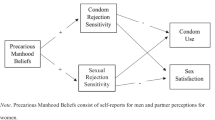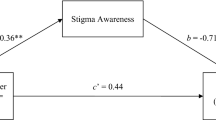Abstract
We examined effects of proposer gender and condom negotiation strategy on perceptions of condom proposers in undergraduates in the southwestern regions of the US. Using a video manipulation (N = 150), a female proposer was evaluated no more harshly than a male proposer, and was evaluated more positively in some ways. In a vignette manipulation (N = 193) a female proposer using an Eroticization negotiation strategy (compared to Refusal of sex or Explanation of consequences) was seen as more exciting and likely to engage in sex. Surprisingly, women were harsher judges than men of a female condom proposer using an Eroticization strategy. Greater attention should be paid to the nature of condom negotiation within the framework of the sexual script.
Similar content being viewed by others
References
Allen, M., Emmers-Sommer, T. M., & Crowell, T. L. (2002). Couples negotiating safer sex behaviors: A meta-analysis of the impact of conversation and gender. In M. Allen, R. W. Preiss, B. M. Gayle, & N. A. Burrell (Eds.), Interpersonal communication research: Advances through meta-analysis (pp. 263–279). Mahwah: Erlbaum.
Altermatt, T. W., DeWall, C. N., & Leskinen, E. (2003). Agency and virtue: Dimensions underlying subgroups of women. Sex Roles, 49, 631–641.
Aubrey, J. S. (2004). Sex and punishment: An examination of sexual consequences and the sexual double standard in teen programming. Sex Roles, 50, 505–514.
Barash, D. P., & Lipton, J. E. (2001). The myth of monogamy. New York: Freeman.
Bargh, J. A., Chen, M., & Burrows, L. (1996). Automaticity of social behavior: Direct effects of trait construct and stereotype activation on action. Journal of Personality and Social Psychology, 71, 230–244.
Baumeister, R. F., & Vohs, K. D. (2004). Sexual economics: Sex as female resource for social exchange in heterosexual interactions. Personality and Social Psychology Review, 8, 339–363.
Baumeister, R. F., Catanese, K. R., & Vohs, K. D. (2001). Is there a gender difference in strength of sex drive? Theoretical views, conceptual distinctions, and a review of relevant evidence. Personality and Social Psychology Review, 5, 242–273.
Bird, S. T., Harvey, S. M., Beckman, L. J., & Johnson, C. H. (2001). Getting your partner to use condoms: Interviews with men and women at risk of HIV/AIDS. The Journal of Sex Research, 38, 233–240.
Boer, H., & Mashamba, M. T. (2007). Gender power imbalance and differential psychosocial correlates of intended condom use among male and female adolescents from Venda, South Africa. British Journal of Health Psychology, 12, 51–63.
Bryan, A. D., Aiken, L. S., & West, S. G. (1999). The impact of males proposing condom use on perceptions of an initial sexual encounter. Personality and Social Psychology Bulletin, 25, 275–286.
Carter, J. A., McNair, L. D., Corbin, W. R., & Williams, M. (1999). Gender differences related to heterosexual condom use: The influence of negotiation styles. Journal of Sex and Marital Therapy, 25, 217–225.
Centers for Disease Control. (2005). Trends in reportable sexually transmitted diseases in the United States, 2005. Retrieved from the Centers for Disease Control and Prevention Web site: http://www.cdc.gov/std/stats/trends2005.htm#ref1.
Centers for Disease Control. (2008). Nationally representative CDC study finds 1 in 4 teenage girls has a sexually transmitted disease. Retrieved from Centers for Disease Control and Prevention Web site: http://www.cdc.gov/stdconference/2008/media/release-11march2008.pdf.
Conley, T. D., & Collins, B. E. (2002). Gender, relationship status, and stereotyping about sexual risk. Personality and Social Psychology Bulletin, 28, 1483–1494.
Cooper, M. L., Shapiro, C., & Powers, A. M. (1998). Motivations for sex and risky sexual behavior among adolescents and young adults: A functional perspective. Journal of Personality and Social Psychology, 75, 1528–1558.
Davila, Y. R., & Brackley, M. H. (1999). Mexican and Mexican American women in a battered women’s shelter: Barriers to condom negotiation for HIV/AIDS prevention. Issues in Mental Health Nursing, 20, 333–355.
Diekman, A. B., McDonald, M., & Gardner, W. L. (2000). Love means never having to be careful: The relationship between reading romance novels and safe sex behaviors. Psychology of Women Quarterly, 24, 179–188.
Diekman, A. B., Goodfriend, W., & Goodwin, S. (2004). Dynamic stereotypes of power: Perceived change and stability in gender hierarchies. Sex Roles, 50, 201–215.
Eagly, A. H., Wood, W., & Diekman, A. B. (2000). Social role theory of sex differences and similarities: A current appraisal. In T. Eckes & H. M. Trautner (Eds.), The developmental social psychology of gender (pp. 123–174). Mahwah: Erlbaum.
Edgar, T., & Fitzpatrick, M. A. (1993). Expectations for sexual interaction: A cognitive test of the sequencing of sexual communication behaviors. Health Communication, 5, 239–261.
Fiske, S. T., Cuddy, A. J., Glick, P., & Xu, J. (2002). A model of (often mixed) stereotype content: Competence and warmth respectively follow from perceived status and competition. Journal of Personality and Social Psychology, 82, 878–902.
Gagnon, J. H. (1990). The explicit and implicit use of the scripting perspective in sex research. Annual Review of Sex Research, 1, 1–44.
Hynie, M., & Lydon, J. E. (1995). Women’s perceptions of female contraceptive behavior: Experimental evidence of the sexual double standard. Psychology of Women Quarterly, 19, 563–581.
Hynie, M., Lydon, J. E., & Taradash, A. (1997). Commitment, intimacy, and women’s perceptions of premarital sex and contraceptive readiness. Psychology of Women Quarterly, 21, 447–464.
Hynie, M., Schuller, R. A., & Couperthwaite, L. (2003). Perceptions of sexual intent: The impact of condom possession. Psychology of Women Quarterly, 27, 75–79.
Kelly, J., & Bazzini, D. G. (2001). Gender, sexual experience, and the sexual double standard: Evaluations of female contraceptive behavior. Sex Roles, 45, 785–799.
Koukounas, E., & Letch, N. M. (2001). Psychological correlates of perception of sexual intent in women. The Journal of Social Psychology, 14, 443–456.
Marks, M. J., & Fraley, R. C. (2005). The sexual double standard: Fact or fiction? Sex Roles, 52, 175–186.
Milhausen, R. R., & Herold, E. S. (2001). Reconceptualizing the sexual double standard. Journal of Psychology and Human Sexuality, 13, 63–83.
Noar, S. M., & Edgar, T. (2008). The role of partner communication in safer sexual behavior: A theoretical and empirical review. In T. Edgar, S. M. Noar, & V. S. Freimuth (Eds.), Communication perspectives on HIV/AIDS for the 21st century. LEA’s communication series (pp. 3–28). New York: Erlbaum/Taylor & Francis.
Noar, S. M., Morokoff, P. J., & Harlow, L. L. (2002). Condom negotiation in heterosexually active men and women: Development and validation of a condom influence strategy questionnaire. Psychology & Health, 17, 711–735.
Noar, S. M., Carlyle, K., & Cole, C. (2006). Why communication is crucial: Meta-analysis of the relationship between safer sexual communication and condom use. Journal of Health Communication, 11, 365–390.
Rose, S., & Frieze, I. H. (1993). Young singles’ contemporary dating scripts. Sex Roles, 28, 499–509.
Schroder, K. E. E., Johnson, C. J., & Wiebe, J. S. (2009). An event-level analysis of condom use as a function of mood, alcohol use, and safer sex negotiations. Archives of Sexual Behavior, 38, 283–289.
Serewicz, M. C. M., & Gale, E. (2008). First-date scripts: Gender roles, context, and relationship. Sex Roles, 58, 149–164.
Simon, W., & Gagnon, J. H. (1986). Sexual scripts: Permanence and change. Archives of Sexual Behavior, 15, 97–120.
Simpson, J. A., & Gangestad, S. W. (1991). Individual differences in sociosexuality: Evidence for convergent and discriminant validity. Journal of Personality and Social Psychology, 60, 870–883.
Sri Krishnan, A. K., Hendriksen, E., Vallabhaneni, S., Johnson, S. L., Raminani, S., Kumarasamy, N., Safren, S. A. (2007). Sexual behaviors of individuals with HIV living in South India: A qualitative study. AIDS Education and Prevention, 19, 334–345.
Van der Straten, A., King, R., Grinstead, O., Vittinghoff, E., Serufilira, A., & Allen, S. (1998). Sexual coercion, physical violence, and HIV infection among women in steady relationships in Kigali, Rwanda. AIDS & Behavior, 2, 61–73.
Wiederman, M. W. (2005). The gendered nature of sexual scripts. The Family Journal, 13, 496–502.
Williams, S. P., Gardos, P. S., Ortiz-Torres, B., Tross, S., & Ehrhardt, A. A. (2001). Urban women’s negotiation strategies for safer sex with their male partners. Women & Health, 33, 149–165.
Wingood, G. M., & DiClemente, R. J. (2000). Application of the Theory of Gender and Power to examine HIV-related exposures, risk factors, and effective interventions for women. Health Education & Behavior, 27, 539–565.
Acknowledgments
Preparation of this manuscript was supported, in part, by center grant P30-MH52776 from the National Institute of Mental Health and by NRSA postdoctoral training grant T32-MH19985.
Author information
Authors and Affiliations
Corresponding author
Rights and permissions
About this article
Cite this article
Broaddus, M.R., Morris, H. & Bryan, A.D. ‘It’s Not What You Said, It’s How You Said It’: Perceptions of Condom Proposers by Gender and Strategy. Sex Roles 62, 603–614 (2010). https://doi.org/10.1007/s11199-009-9728-z
Published:
Issue Date:
DOI: https://doi.org/10.1007/s11199-009-9728-z




